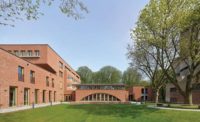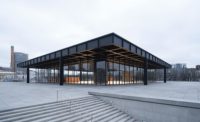With rose-hued Neckertäler sandstone on the facade and gray slate tiles cladding the high-pitched roofs, the extension to the Historical Museum Frankfurt feels as if it has been around for decades, although it just opened in October. Designed by Stuttgart-based architects Lederer Ragnarsdóttir Oei, for a prominent inner-city site—wedged between the Saalhof, a complex dating from the 13th to 19th centuries that houses the original museum, on the south, and the Medieval Saint Nicholas Church and Frankfurt’s old city square, the Römer, on the north—the regional materials and local references are explicit. It was imperative that the new building, which replaces a sprawling concrete addition from the 1970s, forge an emotional bond with a public that had grown weary of such big, postwar projects. “Frankfurt suffered greatly during postwar reconstruction,” says Arno Lederer. “There was a euphoria among architects and planners [about modern building] from the end of the war to the 1970s, but this kind of architecture was not popularly accepted.”
Additional Content:
Jump to credits & specifications
When the architects entered a limited competition a decade ago, they began by looking at the area’s prewar urban plan. Taking a cue from a narrow street that had once crossed the site, they distributed the 108,000 square feet of program into two long structures—a freestanding exhibition building to the north and a wing for the entrance and offices integrated into the Saalhof to the south—leaving a funnel-shaped through-block entrance court in between. An underground foyer connects the two structures.
At every turn, the new building reveals the city’s past. Accessed on grade to the east and via stairs to the west, the entrance court feels like “an open-air museum room,” as Lederer says, with the 12th-century Stauffer tower, the 15th-century timber-frame House Wertheym, and archeological excavations all visible. At the center, a large periscope with views from two sides allows visitors glimpses of exhibits in the below-grade foyer before they even enter the museum. Paved with a purple-gray basalt lava stone, the court creates a spatial connection to the surrounding urban fabric, while the new facades engage the context with inventive surface articulations and carefully situated fenestration. For example, a band of ground-floor windows permits not only views into the lobby but to the Saalhof beyond.
The choice of materials and their application are also sympathetic to Frankfurt’s historic architecture. The rear-ventilated sandstone facade is in fact “laid brickwork with a large-format stone,” says project manager Daniel Steinhübl. It is supported by steel brackets and attached to the building’s reinforced steel structure. The colored mortar used for the deeply recessed horizontal and thin vertical joints matches the sandstone. The surface is inscribed with a diamond pattern consisting of smooth and pointed areas, and circular forms at the center of each diamond are either left flat or accommodate air vents. These articulations create the impression of a light enclosure, like the diagonal timber framing on House Wertheym, or “a pattern on a carpet,” says Jórunn Ragnarsdóttir.
The facades of the exhibition building have the same construction, without the diamond pattern. Monumental niches, surfaced in rough-finished, ivory plaster, display sculptures and spolia over the length of the long sides. The westernmost niche on each facade is glazed to allow views from the galleries to the city. Small stone panels, turned slightly ajar, like a field of window shutters, form openings that illuminate the stairwells on the shorter eastern and western sides.
Warm-toned metal details—copper for the roof gutters and drains, bronzed tombac sheet metal for the projecting window atop the exhibition building, architectural bronze for the openings on the entrance building, and polished brass sheathing on the double periscope—create visual linkages between the two structures.
Today the long-awaited Historical Museum extension—whose construction was prolonged due to demolition of the earlier building, the discovery of unexpected archeological artifacts, and complicated foundation work—feels both dignified and inextricably rooted in its context. “It is connected to the city,” says Lederer, “not as a reconstruction but an improvement.”
CreditsArchitect: LRO Lederer Ragnarsdóttir Oei GmbH & Co. KG
Personnel in architect's firm who should receive special credit: project architects:
Engineers Structural engineering: Lenz Weber Ingenieure GmbH, Frankfurt am Main Controlling engineers: Werner Sobek Frankfurt GmbH & Co. KG, Frankfurt am Main Engineering for technical building facilities: ZWP Ingenieur AG, Wiesbaden Electrical engineering: Steinigeweg Planungs GmbH & Co KG, Darmstadt Consultants structural physics: Bobran Ingenieure Akustik + Bauphysik, Stuttgart geotechnics: ISK Ingenieursgesellschaft mbH, Rodgau lift planners: Beiersdorf Herzhauser Planung, Frankfurt architects rebuilding the existing housing stock: DIEZINGER & KRAMER, Diezinger Architekten GmbH, Eichstätt
Photographer: Roland Halbe, tel +49 711 6074073, © Roland Halbe, Stuttgart |
Specifications |




















